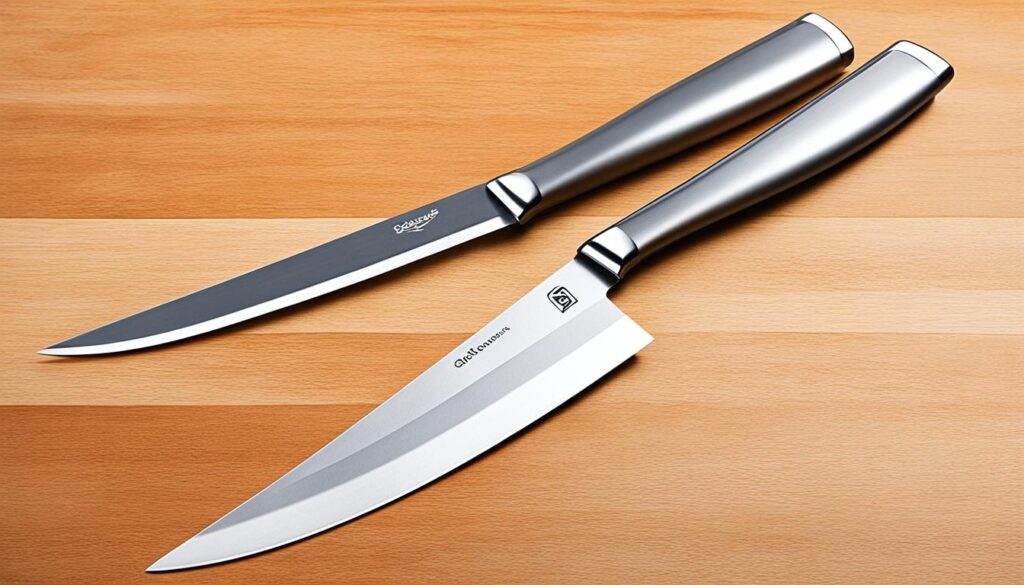Did you know that the average American household owns an astonishing 15 knives? From the versatile chef’s knife to the precision of a paring knife, these essential tools are the foundation of any well-equipped kitchen. In this comprehensive guide, we will explore the different types of knives, their essential uses, and the key considerations when selecting and maintaining them.
Whether you’re an avid home cook or a culinary enthusiast, understanding the nuances of knives can greatly enhance your kitchen skills and prepare you for any cooking task. From the cutting techniques to the blade materials, we’ll cover the essential tools every kitchen needs and provide tips on how to properly care for and sharpen your blades. Get ready to elevate your culinary experience with our in-depth look at the world of knives.
Knives: Essential Tools for Every Kitchen
Knives are the essential tools in any well-equipped kitchen, serving as the foundation for food preparation and culinary mastery. Among the most versatile and indispensable knives are the chef’s knives, paring knives, and utility knives.
Chef’s Knives: The Versatile Workhorses
The chef’s knife is the workhorse of the kitchen, renowned for its exceptional chopping, dicing, and slicing capabilities. With its broad, curved blade, the chef’s knife excels at a wide range of food preparation tasks, from mincing herbs to slicing meats. Its versatility makes it an indispensable tool for home cooks and professional chefs alike.
Paring Knives: Precision in Small Packages
For intricate food preparation tasks that require pinpoint accuracy, the paring knife is the perfect tool. With its small, sharp blade, the paring knife is ideal for peeling, deveining, and trimming fruits and vegetables, as well as performing other delicate chopping and slicing operations.
Utility Knives: The All-Purpose Performers
Bridging the gap between the chef’s knife and the paring knife, the utility knife is a versatile kitchen knife that can handle a wide range of food preparation tasks. With a blade size that falls between the two, the utility knife excels at slicing, dicing, and chopping a variety of ingredients, making it a valuable addition to any kitchen knife collection.
Exploring Different Types of Knives
Beyond the essential knives found in every kitchen, there are several specialized types designed for specific tasks. These include carving knives, bread knives, and boning knives.
Carving Knives: Slicing Perfection
Carving knives are the go-to tools for masterful slicing, whether you’re preparing a succulent roast or a mouthwatering ham. With their long, thin blades, carving knives allow you to execute clean, even cuts, ensuring your meat presentation is as impressive as the flavor. These carving knives are indispensable for slicing and carving various protein-rich dishes.
Bread Knives: Preserving the Loaf’s Delicacy
Slicing through a fresh loaf of bread can be a delicate task, which is where the bread knife shines. Its serrated blade gently cuts through the crust without tearing or crushing the soft interior, preserving the integrity of your baked goods. Whether you’re slicing artisanal sourdough or fluffy sandwich bread, a quality bread knife is essential for maintaining the delicacy of your loaf.
Boning Knives: Mastering Meat Preparation
For the home chef who takes pride in meat preparation, the boning knife is an invaluable tool. With its narrow, flexible blade, a boning knife allows for precision deboning and slicing of meats, making it easier to remove bones and separate connective tissue. Whether you’re breaking down a whole chicken or preparing a rack of ribs, a quality boning knife is essential for mastering meat preparation.

Knife Materials: What You Need to Know
When selecting the perfect kitchen knives, the material of the blade is a crucial consideration. From the durable and low-maintenance stainless steel to the razor-sharp ceramic options, each type of knife material offers unique benefits that cater to different culinary needs. Let’s explore the three most popular and widely used knife materials:
Stainless Steel: Durable and Low-Maintenance
Stainless steel is a classic and versatile choice for kitchen knives. This material is renowned for its durability, corrosion resistance, and easy maintenance. Stainless steel blades are less prone to rust and can withstand frequent use with minimal care. They’re a great option for home cooks who prioritize convenience and long-lasting performance in the kitchen.
High-Carbon Steel: Sharp and Enduring
High-carbon steel is a preferred material among professional chefs and serious home cooks. These blades are renowned for their exceptional sharpness and edge retention, allowing you to slice through ingredients with precision and efficiency. While they may require slightly more maintenance than stainless steel, high-carbon steel knives offer unparalleled cutting performance and can be honed to a razor-sharp edge.
Ceramic Knives: Razor-Sharp Edges
Ceramic knives have gained popularity in recent years for their unique properties. Made from a high-quality ceramic material, these blades are exceptionally sharp, resistant to corrosion, and maintain their edge longer than traditional steel knives. Ceramic knives are lightweight, making them easy to maneuver, and their non-stick properties can prevent certain ingredients from sticking to the blade.
